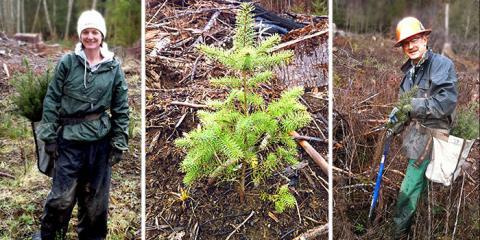Tree planting, AGAIN!
March 26, 2013
Up early and ready to go on a recent winter morning, my husband Rex and my 21-year-old son Nick headed to our 89-acre family forestland plot near Mist in Oregon’s northern Coast Range. Today’s mission: plant Douglas-fir seedlings on six acres where we burned slash piles last fall, and replace seedlings that didn’t make it through the summer.
Replanting trees after harvest is Oregon law, and making sure they are “free to grow” in five years is another requirement of the Oregon Forest Practices Act – but we’d do it anyway, because it’s in our interest to do so.
Upon arrival, the weather was true to the nearby town’s name, because the skies were certainly misty. But compared to last year when we planted most of the six acres in the cold and rain, the lightly moist sky was an improvement, and we all appreciated those better conditions. I can honestly say I have newfound appreciation for the professionals who do this work day in and day out, planting 40-million-some trees every year in our state in all kinds of conditions.
After giving Nick a quick tree-planting lesson, we were on the job. Due to the high survival rate from last year’s planting, we mainly planted seedlings around and in last year’s burned slash piles. Working diligently and only stopping for a quick lunch, we wrapped up planting by mid-afternoon and were happy to leave for home – except for my husband. Rex wanted to linger, because he’s a true forester.
For now, my tree-planting days are over. Yay! But there’s still more work to do. We’ll spend chunks of time managing brush, weeds and alder seedlings to allow the Douglas-fir to reach “free to grow” condition, as required under law. But in six years, the trees will tower over the underbrush, and then we can sit back and watch them grow. And that’s very gratifying, because we know we did it right.
Kathy Storm
Manager of Business Operations
